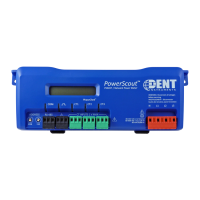91
Appendix B—Connecting Multiple PowerScouts to an RS-485 Network
This section describes setting up a network with multiple PowerScout instruments using the BACnet or
Modbus communication protocol. An RS-485 network can support up to 127 PowerScout 3037
instruments using the BACnet protocol and 247 PowerScout 3037 instruments using the Modbus
protocol.
COMMUNICATION PROTOCOL
BACnet MS/TP and Modbus RTU are standard communication protocols that allow for communication
between a client and multiple devices connected to the same network. RS-485 is the protocol standard
used by PowerScout meters as the hardware’s physical interface while BACnet or Modbus is the
networking protocol.
DAISY CHAIN LAYOUT FOR RS-485 NETWORK
When multiple devices are connected, the devices need to be connected in a daisy chain. A daisy chain
means that all plus (+) connections are chained together and all minus (-) connections are chained
together across the network.
A network containing multiple devices requires a unique address for each device. This allows the master
device to identify and communicate with each slave. The BACnet/Modbus network administrator must
assign a unique network address to each PowerScout 3037 using the rotary switches MSB and LSB.
Other network layouts, i.e., star, are not recommended when using the RS-485 standard.
NETWORKING USING THE BACNET MS/TP/MODBUS RTU PROTOCOL
1) Install the RS-485 cable on the RS-485 communications terminal block.
2) Set a unique address for each device using the table in Establishing Communication Protocol in the
Prepping for Field Installation section.
www.GlobalTestSupply.com
Find Quality Products Online at: sales@GlobalTestSupply.com

